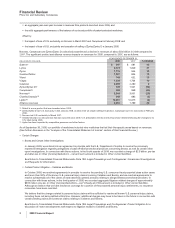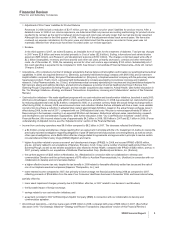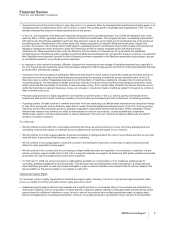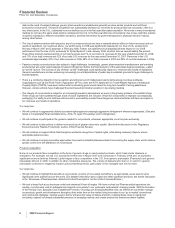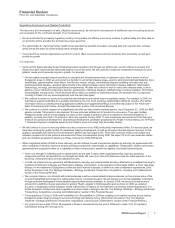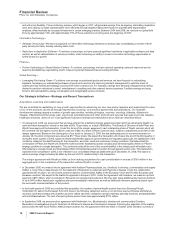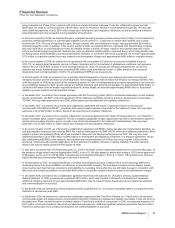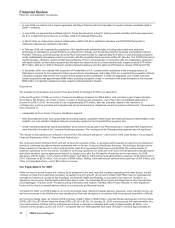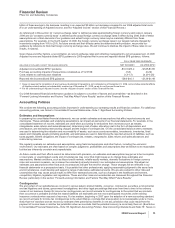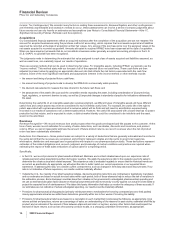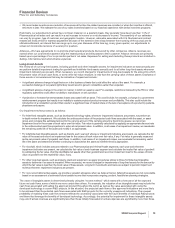Pfizer 2008 Annual Report Download - page 7
Download and view the complete annual report
Please find page 7 of the 2008 Pfizer annual report below. You can navigate through the pages in the report by either clicking on the pages listed below, or by using the keyword search tool below to find specific information within the annual report.
Financial Review
Pfizer Inc and Subsidiary Companies
•Governments around the world continue to seek discounts on our products, either by leveraging their significant purchasing power or by
mandating prices or implementing various forms of price controls. The growing power of managed care organizations in the U.S. has
similarly increased the pressure on pharmaceutical prices and access.
•In the U.S., the enactment of the Medicare Prescription Drug Improvement and Modernization Act of 2003 (the Medicare Act), which
went into effect in 2006, expanded access to medicines for Medicare beneficiaries. This program has been successfully implemented,
with high levels of beneficiary satisfaction and lower-than-expected costs to the government and to beneficiaries due to the enhanced
purchasing power of health plans in the private sector that enables negotiation on behalf of Medicare beneficiaries. Despite this
success, the exclusive role of private sector health plans in negotiating prices for the Medicare drug benefit remains controversial and
legislative changes have been proposed to allow the Federal government to directly negotiate prices with pharmaceutical
manufacturers. While expanded access under the Medicare Act has resulted in increased use of our products, the substantial
purchasing power of health plans that negotiate on behalf of Medicare beneficiaries has increased the pressure on prices. It is expected
that if legislation were enacted to provide for direct Federal government negotiation in the Medicare prescription drug program, access
to and reimbursement for our products would be restricted.
•In response to cost concerns by payers, utilization of generics is increasing as a percentage of total pharmaceutical use, especially in
the U.S. Payers are also selectively sponsoring campaigns designed to interchange generic products for molecularly dissimilar branded
products within a therapeutic category.
•Consumers have become aware of global price differences that result from price controls imposed by certain governments and some
have become more vocal about their desire that governments allow the sourcing of medicines across national borders. In the U.S.,
there have been a number of legislative proposals to permit importation of medicines, despite the increased risk of receiving inferior,
counterfeit products. The Secretaries of Health and Human Services in both the Clinton and Bush Administrations declined to certify
under current law that importation of medicines is safe and saves money. If the new Secretary of Health and Human Services were to
certify that importation is safe and does save money, an increase in cross-border trade in medicines subject to foreign price controls in
other countries could occur.
•Pharmaceutical promotion is highly regulated in most markets around the world. In the U.S., there is growing interest at both the
Federal and state level in further restricting marketing communications and increasing the level of disclosure of marketing activities.
•A growing number of health systems in markets around the world are employing cost effectiveness evaluations and using their findings
to help inform pricing and access decisions, especially for newly introduced biopharmaceutical products. In the U.S., there is growing
interest by government and private payers in adopting comparative clinical effectiveness methodologies. While comparative clinical
effectiveness research may enhance our ability to demonstrate the value of our products, it is also possible that comparative
effectiveness research could be implemented in a manner designed to focus on cost, minimize therapeutic differences and restrict
access to innovative medicines.
Our response:
•We will continue to work within the current legal and pricing structures, as well as continue to review our pricing arrangements and
contracting methods with payers, to maximize access to patients and minimize the impact on our revenues.
•We will continue to actively engage patients, physicians and payers in dialogues about the value of our products and how we can best
work with them to prevent and treat disease, and improve outcomes.
•We will continue to encourage payers to work with us early in the development process to ensure that our approved products will
deliver the value expected by those payers.
•We will continue to be a constructive force in helping to shape healthcare policy and regulation of our products. In particular, we are
actively working to support health reform in the U.S. in a way that expands coverage for all Americans (with public subsidies and private
sector delivery), improves quality and provides value to patients.
•On February 10, 2009, we announced plans to make publicly available our compensation of U.S. healthcare professionals for
consulting, speaking engagements and clinical trials. This disclosure will include payments made to practicing U.S. physicians and
other healthcare providers, as well as principal investigators, major academic institutions and research sites for clinical research. We
plan to publish our first annual update on our website in early 2010.
Intellectual Property Rights
Our business model is highly dependent on intellectual property rights, primarily in the form of government-granted patent rights,
and on our ability to enforce and defend those rights around the world.
•Intellectual property legal protections and remedies are a significant factor in our business. Many of our products are protected by a
wide range of patents, such as composition-of-matter patents, compound patents, patents covering processes and procedures and/or
patents issued for additional indications or uses. As such, many of our products have multiple patents that expire at varying dates,
thereby strengthening our overall patent protection. However, once patent protection has expired or been lost prior to the expiration
2008 Financial Report 5




